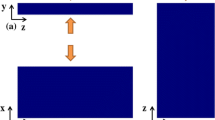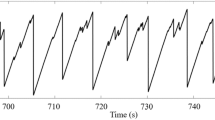Abstract
Understanding of the size effect on shear banding in bulk metallic glasses (BMGs) is currently the topic of active research but also remains under intense debates. In this article, we provide an overview of the recent research findings from experiments, theoretical modeling, and atomistic/continuum simulations which are intended to advance our knowledge related to the size effect on the stability of shear-band propagation in BMGs. Through the compilation of and comparison among the results reported in the literature, we aim at providing a comprehensive understanding of the underlying mechanisms and a unified physical picture of the size effect on shear-band propagation and its resultant ductility in BMGs.










Similar content being viewed by others
References
Klement W, Willens RH, Duwez P (1960) Nature 187:869
Ashby MF, Greer AL (2006) Scripta Mater 54:321
Lu ZP, Liu CT (2004) J Mater Sci 39:3965. doi:10.1023/B:JMSC.0000031478.73621.64
Waseda Y, Aust KT (1981) J Mater Sci 16:2337. doi:10.1007/BF01113569
Davis LA (1975) J Mater Sci 10:1557. doi:10.1007/BF01031856
Schuh CA, Hufnagel TC, Ramamurty U (2007) Acta Mater 55:4067
Zhang Y, Greer AL (2006) Appl Phys Lett 89:071907
Jiang MQ, Wang WH, Dai LH (2009) Scripta Mater 60:1004
Liu YH, Liu CT, Gali A, Inoue A, Chen MW (2010) Intermetallics 18:1455
Yang Y, Ye JC, Lu J, Wang Q, Liaw PK (2010) J Mater Res 25:563
Guo H, Wen J, Xiao NM, Zhang ZF, Sui ML (2008) J Mater Res 23:2133
Spaepen F (1977) Acta Metall 25:407
Argon AS (1979) Acta Metall 27:47
Ye JC, Lu J, Liu CT, Wang Q, Yang Y (2010) Nat Mater 9:619
Hirata A, Guan PF, Fujita T, Hirotsu Y, Inoue A, Yavari AR, Sakurai T, Chen MW (2010) Nat Mater 10:28
Gao YF (2006) Model Simul Mater Sci Eng 14:1329
Homer ER, Rodney D, Schuh CA (2010) Phys Rev B 81:064204
Lewandowski JJ, Greer AL (2006) Nat Mater 5:15
Wright WJ, Schwarz RB, Nix WD (2001) Mater Sci Eng A 319–321:229
Yang B, Liu CT, Nie TG, Morrison ML, Liaw PK, Buchanan RA (2006) J Mater Res 21:915
Wright JL, Samale MW, Hufnagel TC, LeBlanc MM, Florando JN (2009) Acta Mater 57:4639
Chen HM, Huang JC, Song SX, Nieh TG, Jang JSC (2009) Appl Phys Lett 94:141914
Zhao M, Li M (2009) J Mater Res 24:2688
Wu FF, Zhang ZF, Mao SX (2009) Acta Mater 57:257
Wu FF, Zhang ZF, Shen BL, Mao SXY, Eckert J (2008) Adv Eng Mater 10:727
Ye JC, Lu J, Yang Y, Liaw PK (2009) Acta Mater 57:6037
Chen CQ, Hosson JTMD (2010) Acta Mater 58:189
Han Z, Wu WF, Li Y, Wei YJ, Gao HJ (2009) Acta Mater 57:1367
Yang Y, Ye JC, Lu J, Liaw PK, Liu CT (2010) Appl Phys Lett 96:011905
Egami T (2010) JOM-US 62:70
Sheng HW, Luo WK, Alamgir FM, Bai JM, Ma E (2006) Nature 439:419
Miracle DB (2004) Nat Mater 3:697
Fan C, Liaw PK, Wilson TW, Dmowski W, Choo H, Liu CT, Richardson JW, Proffen T (2006) Appl Phys Lett 89:111905
Fan C, Liaw PK, Liu CT (2009) Intermetallics 17:86
Fan C, Ren Y, Liu CT, Liaw PK, Yan HG, Egami T (2011) Phys Rev B 83:195207
Cheng YQ, Ma E (2011) Prog Mater Sci 56:379
Gao YF, Yang B, Nieh TG (2007) Acta Mater 55:2319
Yang Y, Ye JC, Lu J, Gao YF, Liaw PK (2010) Jom 62:93
Cheng YQ, Ma E (2011) Acta Mater 59:1800
Guo H, Yan PF, Wang YB, Tan J, Zhang ZF, Sui ML, Ma E (2007) Nat Mater 6:735
Jang DC, Greer JR (2010) Nat Mater 9:215
Volkert CA, Donohue A, Spaepen F (2008) J Appl Phys 103:083539
Schuster BE, Wei Q, Hufnagel TC, Ramesh KT (2008) Acta Mater 56:5091
Wu XL, Guo YZ, Wei Q, Wang WH (2009) Acta Mater 57:3562
Ye JC, Lu J, Yang Y, Liaw PK (2009) J Mater Res 24:3465
Schuh CA, Nieh TG (2004) J Mater Res 19:46
Song SX, Bei H, Wadsworth J, Nie TG (2008) Intermetallics 16:813
Demetriou MD, Veazey C, Harmon JS, Schramm JP, Johnson WL (2008) Phys Rev Lett 101:145702
Yu HB, Hu J, Xia XX, Sun BA, Li XX, Wang WH, Bai HY (2009) Scripta Mater 61:640
Gu XJ, Poon SJ, Shiflet GJ, Lewandowski JJ (2010) Acta Mater 58:1708
Xie S, George EP (2008) Intermetallics 16:485
Vinogradov A (2010) Scripta Mater 63:89
Dalla Torre FH, Klaumunzer D, Maass R, Loffler JF (2010) Acta Mater 58:3742
Packard CE, Schuh CA (2007) Acta Mater 55:5348
Cao AJ, Cheng YQ, Ma E (2009) Acta Mater 57:5146
Cheng YQ, Han Z, Li Y, Ma E (2009) Phys Rev B 80:134115
Wu FF, Zhang ZF, Mao SX, Eckert J (2009) Philos Mag Lett 89:178
Wu WF, Han Z, Li Y (2008) Appl Phys Lett 93:061908
Wu Y, Li HX, Jiao ZB, Gao JE, Lu ZP (2010) Philos Mag Lett 90:403
Yang Y, Ye JC, Lu J, Liu CT (2011) Intermetallics 19:1005
Wu Y, Li HX, Liu ZY, Chen GL, Lu ZP (2010) Intermetallics 18:157
Johnson WL, Samwer K (2005) Phys Rev Lett 95:195501
Zhang ZF, Eckert J, Schultz L (2003) Acta Mater 51:1167
Greer AL (2009) Mater Today 12:14
Zhang H, Maiti S, Subhash G (2008) J Mech Phys Solids 56:2171
Miracle DB, Concustell A, Zhang Y, Yavari AR, Greer AL (2011) Acta Mater 59:2831
Liu CT, Heatherly L, Easton DS, Carmichael CA, Schneibel JH, Chen CH, Wright JL, Yoo MH, Horton JA, Inoue A (1998) Metall Mater Trans A 29A:1811
Sun L, Jiang MQ, Dai LH (2010) Scripta Mater 63:945
Liu YH, Liu CT, Wang WH, Inoue A, Sakurai T, Chen MW (2009) Phys Rev Lett 103:065504
Lewandowski JJ, Wang WH, Greer AL (2005) Philos Mag Lett 85:77
Yokoyama Y, Fujita T, Yavari AR, Inoue A (2009) Phill Mag Lett 89:322
Pampillo CA (1975) J Mater Sci 10:1194. doi:10.1007/BF00541403
Wright WJ, Hufnagel TC, Nix WD (2003) J Appl Phys 93:1432
Acknowledgements
Y.Y. is grateful to the financial support provided by the Hong Kong Polytechnic University for newly recruited academic staff (project code G-YH85), and the Research Grant Council (RGC), the Hong Kong Government, through the General Research Fund (GRF) with a project number of PolyU 5359/09E. Y.Y. is thankful to the graduate student, J.C. Ye, for conducting and analyzing the data of the microcompression experiments on the Fe-based MG micropillars, from which Fig. 9c is generated.
Author information
Authors and Affiliations
Corresponding author
Appendix: The α parameter and the extrinsic length scale L ext
Appendix: The α parameter and the extrinsic length scale L ext
The theoretical derivation of the α parameter has been detailed in our recent work [60]. For the information of readers, the general expression for the α parameter is introduced here. According to the dimensional analysis, the α parameter can be expressed as follows for a cylindrical BMG sample compressed between two cylindrical compression platens:
where the symbols D, H, E, and ν denote the object diameter, the object height, the Young’s modulus, and the Poisson’s ratio, respectively. For the BMG sample, those symbols carry no subscript; while for the compression platens, they are labeled with a subscript (1 = upper platen and 2 = lower platen), as shown in Fig. 11. Here Π represents a dimensionless function of which the exact functional form is not known yet.
For microcompression tests, the upper platen is a diamond punch that may be assumed as a rigid body (E 1 = ∞), and the lower one is the base material, which can be regarded as an elastic half infinite space (D 1 = ∞ and H 1 = ∞) and possesses the same material properties as the micropillar. In such a case, the functional form of the α parameter is reduced to \( \alpha = \alpha \left( \nu \right) \), which only depends on the Poisson’s ratio of the BMG. Through the FE simulation, one may fit the simulated values of the α parameter to a linear function, which reads \( \alpha = {{4\left( {5.6 - 4\nu } \right)} \mathord{\left/ {\vphantom {{4\left( {5.6 - 4\nu } \right)} \pi }} \right. \kern-\nulldelimiterspace} \pi } \) [26]. Assuming an average Poisson’s ratio of ~0.35 for BMGs, the α parameter can be then estimated as around ~5. As such, the corresponding extrinsic length scale L ext can be expressed as \( L_{\text{ext}} = H + 5D \).
For regular compression tests, the α parameter is a multivariable function. For simplicity, let us assume that both upper and lower platens are made of the same material and possess the same size and geometry (E 1 = E 2, D 1 = D 2, H 1 = H 2, and ν 1 = ν 2). As such, Eq. 7 can be simplified to:
In principle, FE simulations can be performed to attain a proper functional form for Π 1 that fits the elastic boundary conditions set in a real experiment as seen in [26]. After that, the corresponding extrinsic length scale L ext can be derived and then utilized for studying the size effect in a quantitative manner. Here, for the sake of demonstration, we assume the following functional form for Π 1 for a finite platen size without resorting to the FE simulations:
where the exponent x, y and the single-variable function f are to be fitted out by FE simulations. Substituting (9) into (3a) then gives the corresponding extrinsic length scale L ext:
in which \( k_{\text{M}} = {{\pi E_{1} D_{1}^{2} } \mathord{\left/ {\vphantom {{\pi E_{1} D_{1}^{2} } 4}} \right. \kern-\nulldelimiterspace} 4}H_{1} \) is the machine stiffness. Now, if we further assume x = y = f(ν1) = 1, (10) is therefore simplified to:
Comparing (11) to Eq. 2 in the main text, it can be easily seen that the general size-effect model described here is now reduced to the size-effect model developed by Cheng et al. [56] and their proposed shear-band instability index (S new) is equivalent to the extrinsic length scale, L ext, of a special form.
Rights and permissions
About this article
Cite this article
Yang, Y., Liu, C.T. Size effect on stability of shear-band propagation in bulk metallic glasses: an overview. J Mater Sci 47, 55–67 (2012). https://doi.org/10.1007/s10853-011-5915-8
Received:
Accepted:
Published:
Issue Date:
DOI: https://doi.org/10.1007/s10853-011-5915-8





